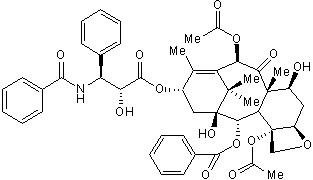Paclitaxel Powder
Formula | C47H51NO14 |
Synonyms | Paclitaxel, taxol |
Appearance | White crystalline solid |
CAS number | 33069-62-4 |
Purity | 98% HPLC |
Source | Taxus brevifolia ( a plant extract) |
Structural classification | Cyclodecane-Antitumor agent |
Storage | Store in a freezer upon arrival, at -10°C to -25°C |
Description of bulk Paclitaxel Powder
Paclitaxel Powder, also known as Taxol, is a natural chemotherapy agent originally derived from the bark of the Pacific yew tree (Taxus brevifolia). It belongs to a class of drugs known as taxanes and is primarily used in the treatment of various cancers, including ovarian, breast, and non-small cell lung cancer.
Paclitaxel Powder is originally derived from the bark of the Pacific yew tree, it can now be produced through semi-synthetic processes using plant cell cultures or through complete synthesis. Paclitaxel is highly valued in oncology due to its effectiveness, but its production and extraction process were initially unsustainable because it required large amounts of yew bark. Advances in biotechnology have allowed for more sustainable production methods, including the use of plant cell cultures.
Bulk Paclitaxel Powder is for sale at a competitive price.
Specification
M. Wt | 853.92 |
Formula | C47H51NO14 |
Storage | Store at -10°C to -25°C |
Purity | ≥98% (HPLC) |
CAS Number | 33069-62-4 |
PubChem ID | 441276 |
InChI Key | RCINICONZNJXQF-VAZQATRQSA-N |
Smiles | O=C2[C@@]3(C)C([C@@]4(OC(C)=O)[C@H](OC4)C[C@@H]3O)[C@H](OC(C7=CC=CC=C7)=O) [C@@]1(O)[C@](C)(C)C([C@H]2OC(C)=O)=C(C)[C@@H](OC([C@H](O)[C@H]([C@]5=CC=CC=C5)NC(C6=CC=CC=C6)=O)=O)C1 |
Applications
Paclitaxel is a chemotherapy drug used to treat various cancers, including breast, ovarian, and lung cancers. It works by stabilizing microtubules, preventing cancer cell division. It’s commonly administered via IV infusion and can cause side effects like neuropathy and neutropenia.
Paclitaxel Powder Reference
How Taxol/paclitaxel kills cancer cells
- Taxol (generic name paclitaxel) is a microtubule-stabilizing drug that is approved by the Food and Drug Administration for the treatment of ovarian, breast, and lung cancer, as well as Kaposi’s sarcoma. It is used off-label to treat gastroesophageal, endometrial, cervical, prostate, and head and neck cancers, in addition to sarcoma, lymphoma, and leukemia. Paclitaxel has long been recognized to induce mitotic arrest, which leads to cell death in a subset of the arrested population. However, recent evidence demonstrates that intratumoral concentrations of paclitaxel are too low to cause mitotic arrest and result in multipolar divisions instead.

